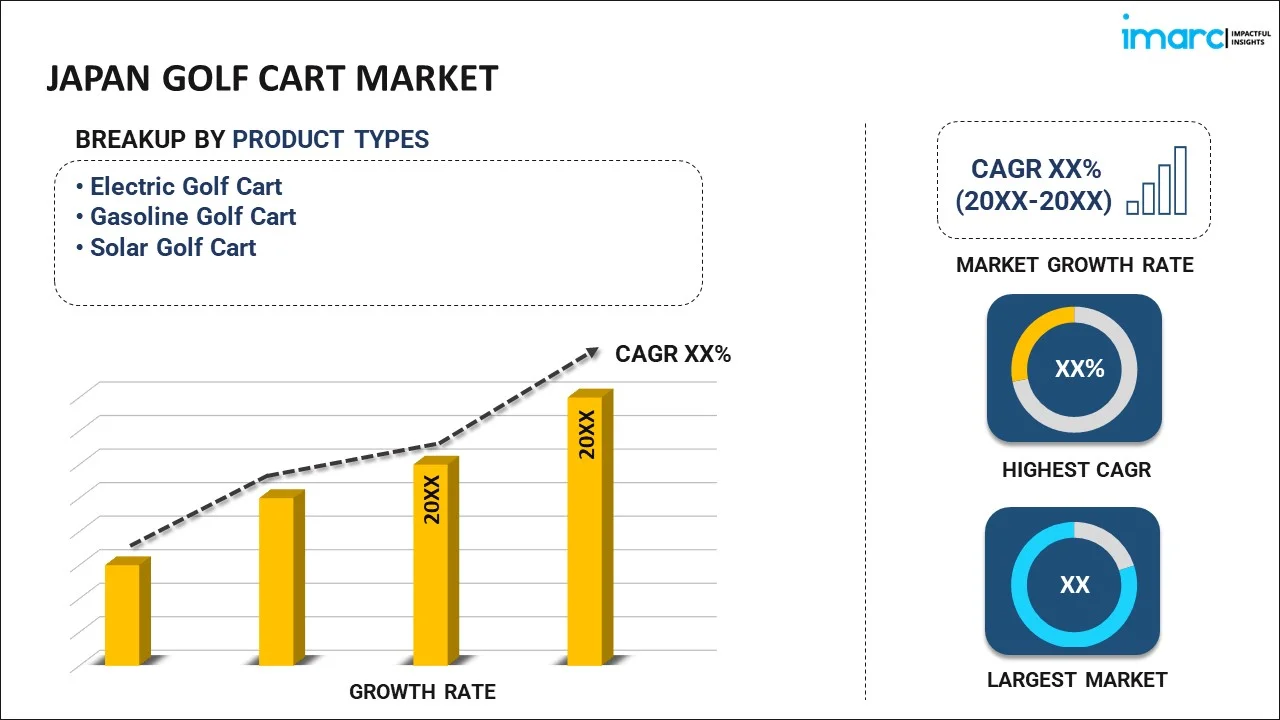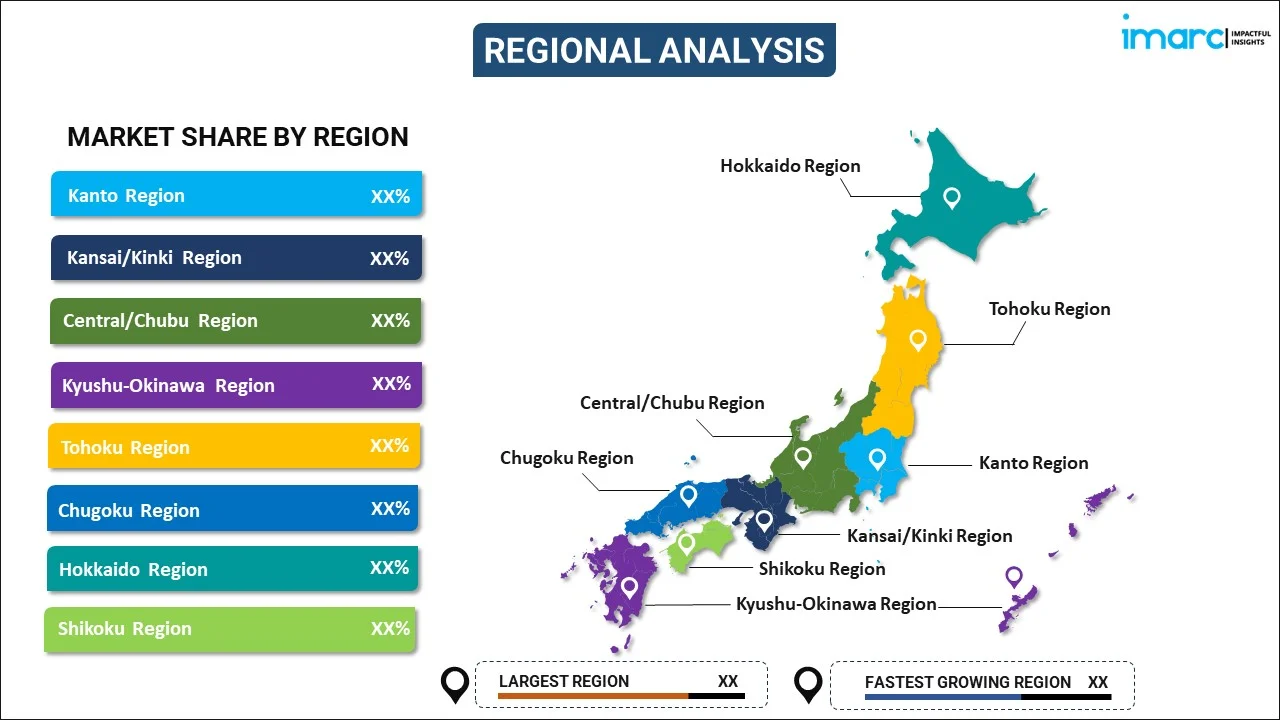
Japan Golf Cart Market Report by Product Type (Electric Golf Cart, Gasoline Golf Cart, Solar Golf Cart), Seating Capacity (Small (2 - 4 Seater), Medium (6 - 8 Seater), Large (Above 8 Seats)), Application (Golf Course, Personal Services, Commercial Services), and Region 2025-2033
Market Overview:
Japan golf cart market size reached USD 114.4 Million in 2024. Looking forward, IMARC Group expects the market to reach USD 182.1 Million by 2033, exhibiting a growth rate (CAGR) of 4.8% during 2025-2033. The increasing advances in golf cart technology, such as improved battery technology, GPS navigation systems, and connectivity features, that can attract buyers looking for enhanced performance and convenience, is driving the market.
|
Report Attribute
|
Key Statistics
|
|---|---|
|
Base Year
|
2024
|
|
Forecast Years
|
2025-2033
|
|
Historical Years
|
2019-2024
|
|
Market Size in 2024
|
USD 114.4 Million |
|
Market Forecast in 2033
|
USD 182.1 Million |
| Market Growth Rate 2025-2033 | 4.8% |
A golf cart is a small, motorized vehicle primarily designed for use on golf courses, although they are also commonly used in various other settings. Typically powered by electric or gasoline engines, golf carts are known for their compact size and low-speed capabilities. They are often used by golfers to transport themselves and their clubs around the course, replacing the need for walking or carrying heavy bags. Golf carts usually feature seating for two to four passengers and a flat platform in the back for carrying golf bags. They are equipped with basic safety features like headlights, taillights, and turn signals for use on roads and pathways. While their primary purpose is on the golf course, golf carts are also used in various other environments, such as resorts, retirement communities, and industrial facilities for transportation over short distances. In recent years, there has been a growing trend toward electric golf carts due to their environmental friendliness and quieter operation, reducing the impact on golf courses and surrounding areas.
Japan Golf Cart Market Trends:
The golf cart market in Japan is experiencing robust growth due to several key drivers. Firstly, the increasing awareness of environmental sustainability has prompted golf courses and resorts to adopt electric golf carts, as they offer a cleaner and more eco-friendly mode of transportation. Furthermore, stringent government regulations aimed at reducing greenhouse gas emissions have incentivized the shift towards electric golf carts, which produce zero tailpipe emissions. Additionally, the growing popularity of golf as a leisure activity and sport has fueled demand for golf carts. Golf carts provide a convenient means of traversing the golf course and can enhance the overall golfing experience. This surge in golfing enthusiasts has translated into a higher demand for golf carts in the market. Moreover, advancements in technology, which have led to the development of more feature-rich golf carts, including GPS navigation, entertainment systems, and improved battery technology for longer ranges, are expected to drive the golf cart market in Japan during the forecast period.
Japan Golf Cart Market Segmentation:
IMARC Group provides an analysis of the key trends in each segment of the market, along with forecasts at the country level for 2025-2033. Our report has categorized the market based on product type, seating capacity, and application.
Product Type Insights:

- Electric Golf Cart
- Gasoline Golf Cart
- Solar Golf Cart
The report has provided a detailed breakup and analysis of the market based on the product type. This includes electric golf cart, gasoline golf cart, and solar golf cart.
Seating Capacity Insights:
- Small (2 - 4 Seater)
- Medium (6 - 8 Seater)
- Large (Above 8 Seats)
A detailed breakup and analysis of the market based on the seating capacity have also been provided in the report. This includes small (2 - 4 seater), medium (6 - 8 seater), and large (above 8 seats).
Application Insights:
- Golf Course
- Personal Services
- Commercial Services
The report has provided a detailed breakup and analysis of the market based on the application. This includes golf course, personal services, and commercial services.
Regional Insights:

- Kanto Region
- Kansai/Kinki Region
- Central/ Chubu Region
- Kyushu-Okinawa Region
- Tohoku Region
- Chugoku Region
- Hokkaido Region
- Shikoku Region
The report has also provided a comprehensive analysis of all the major regional markets, which include Kanto Region, Kansai/Kinki Region, Central/ Chubu Region, Kyushu-Okinawa Region, Tohoku Region, Chugoku Region, Hokkaido Region, and Shikoku Region.
Competitive Landscape:
The market research report has also provided a comprehensive analysis of the competitive landscape in the market. Competitive analysis such as market structure, key player positioning, top winning strategies, competitive dashboard, and company evaluation quadrant has been covered in the report. Also, detailed profiles of all major companies have been provided.
Japan Golf Cart Market Report Coverage:
| Report Features | Details |
|---|---|
| Base Year of the Analysis | 2024 |
| Historical Period | 2019-2024 |
| Forecast Period | 2025-2033 |
| Units | Million USD |
| Scope of the Report | Exploration of Historical Trends and Market Outlook, Industry Catalysts and Challenges, Segment-Wise Historical and Future Market Assessment:
|
| Product Types Covered | Electric Golf Cart, Gasoline Golf Cart, Solar Golf Cart |
| Seating Capacities Covered | Small (2 - 4 Seater), Medium (6 - 8 Seater), Large (Above 8 Seats) |
| Applications Covered | Golf Course, Personal Services, Commercial Services |
| Regions Covered | Kanto Region, Kansai/Kinki Region, Central/ Chubu Region, Kyushu-Okinawa Region, Tohoku Region, Chugoku Region, Hokkaido Region, Shikoku Region |
| Customization Scope | 10% Free Customization |
| Post-Sale Analyst Support | 10-12 Weeks |
| Delivery Format | PDF and Excel through Email (We can also provide the editable version of the report in PPT/Word format on special request) |
Key Questions Answered in This Report:
- How has the Japan golf cart market performed so far and how will it perform in the coming years?
- What has been the impact of COVID-19 on the Japan golf cart market?
- What is the breakup of the Japan golf cart market on the basis of product type?
- What is the breakup of the Japan golf cart market on the basis of seating capacity?
- What is the breakup of the Japan golf cart market on the basis of application?
- What are the various stages in the value chain of the Japan golf cart market?
- What are the key driving factors and challenges in the Japan golf cart?
- What is the structure of the Japan golf cart market and who are the key players?
- What is the degree of competition in the Japan golf cart market?
Key Benefits for Stakeholders:
- IMARC’s industry report offers a comprehensive quantitative analysis of various market segments, historical and current market trends, market forecasts, and dynamics of the Japan golf cart market from 2019-2033.
- The research report provides the latest information on the market drivers, challenges, and opportunities in the Japan golf cart market.
- Porter's five forces analysis assist stakeholders in assessing the impact of new entrants, competitive rivalry, supplier power, buyer power, and the threat of substitution. It helps stakeholders to analyze the level of competition within the Japan golf cart industry and its attractiveness.
- Competitive landscape allows stakeholders to understand their competitive environment and provides an insight into the current positions of key players in the market.
Need more help?
- Speak to our experienced analysts for insights on the current market scenarios.
- Include additional segments and countries to customize the report as per your requirement.
- Gain an unparalleled competitive advantage in your domain by understanding how to utilize the report and positively impacting your operations and revenue.
- For further assistance, please connect with our analysts.
 Inquire Before Buying
Inquire Before Buying
 Speak to an Analyst
Speak to an Analyst
 Request Brochure
Request Brochure
 Request Customization
Request Customization




.webp)




.webp)












